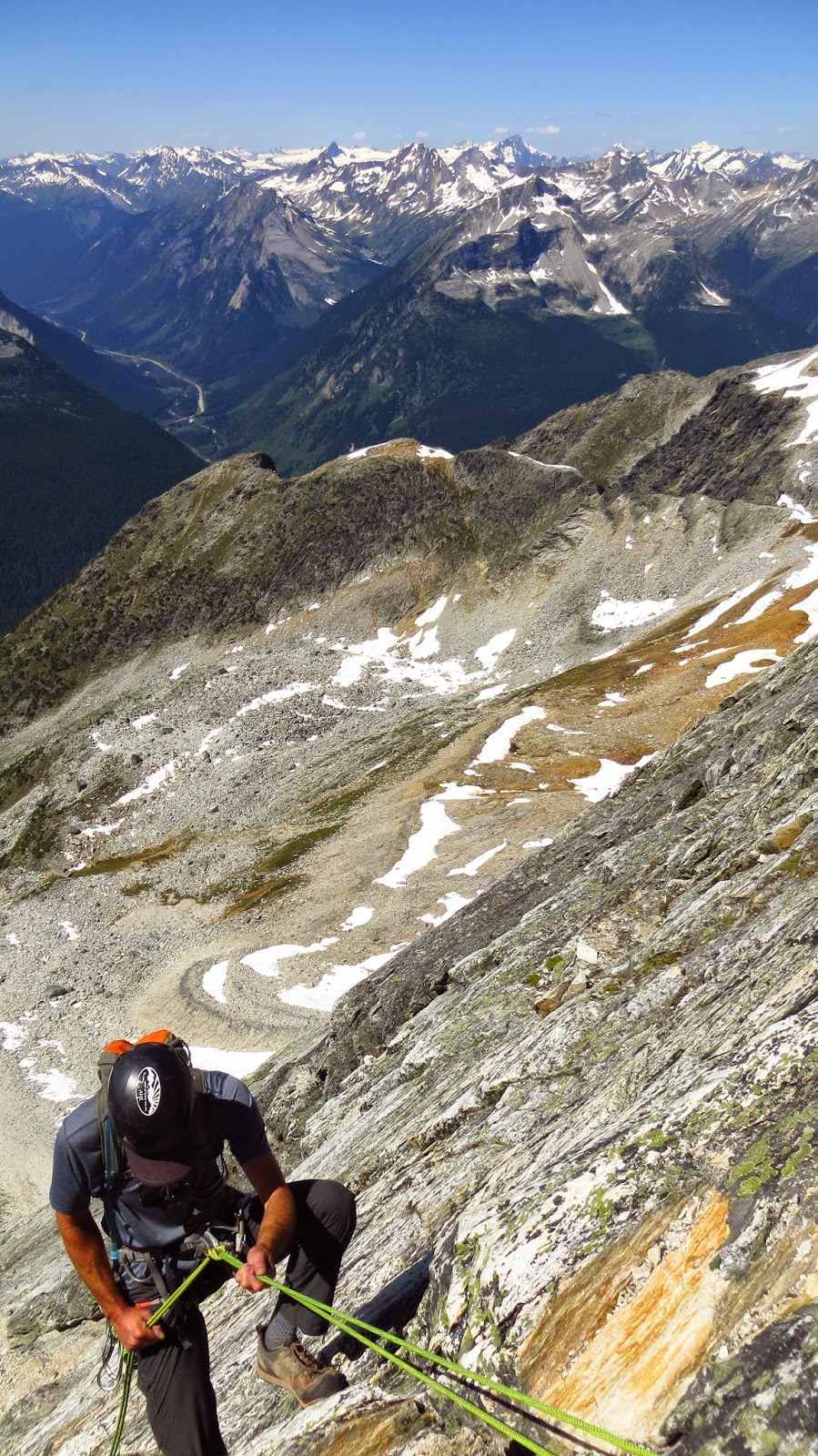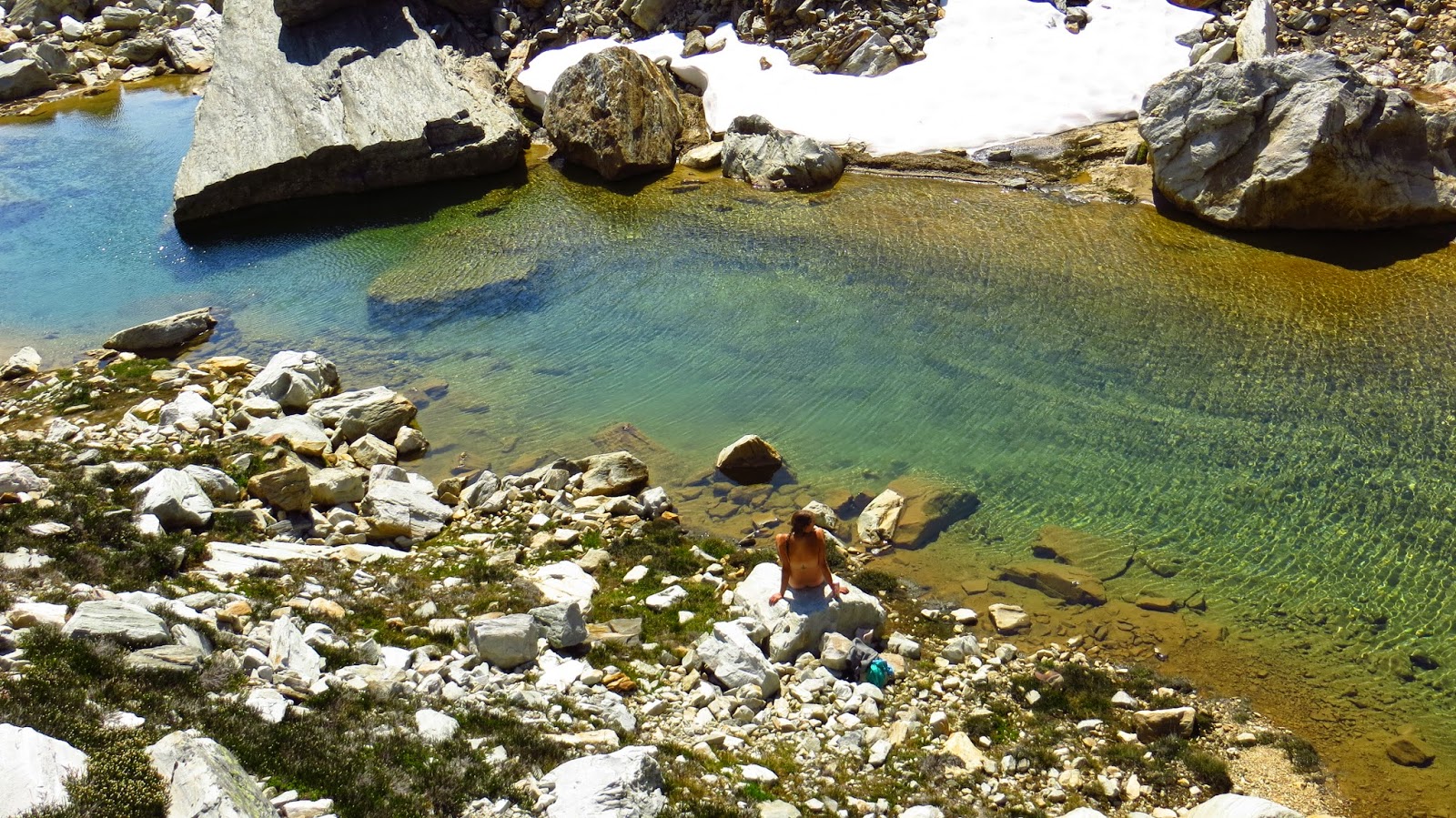In July 2015, I joined a team of Salt Lake City climbers who were returning to Titcomb Basin with some unfinished business of a failed new route attempt on Fremont, due to the conditions they endured the previous August. Unlike them, I had no agenda, only to be apart of this expedition, and to climb the highly acclaimed, impeccable granite that resides in the Wind River Range. In fact I hadn’t even talked to any of my friends about routes we wanted to repeat, or the potential for new ones. I was merely going off the hype of my friend Shingo Ohkawa and that was all I needed. Lucky for me, Greg Troutman was in the same agenda-less boat as me, so we teamed up to make a couple of first ascents.
 |
| Ranger friendly camp, sort of. |
 |
| Crows Nest camp |
 |
The endless West Aspects of Titcomb Basin
Mt Helen stands proud at the back of the basin |
The trip started off early on July 17th, when we met the horse packers from Mule Shoe Outfitters at the Elkheart Park trailhead and began our single push to Island Lake, 12 miles down the trail. We set up base camp at the east side of the lake. “The Crow’s Nest” as we called it, was a prime, centralized launch point for our objectives. It took us another day to make camp cozy, efficient and “ranger friendly.” On day 3, Troutman and I set out for our first mission in Titcomb Basin.
 |
| Me and my new friend |
On July 19th, we opened a new route on the Red Tower which sits just below Fremont’s West Face. We climbed an independent line on the left side of the tower staying just to the left of the long arête (Red Tower Arête - Mark Jenkins, AAJ 2012). The route starts at the lowest toe of the Tower. After a steep, balancy start to get to the main crack system we found solid rock and climbed moderate cracks and corners going practically straight up for 5 pitches. The final pitch was the crux at 5.9+, stepping left into a thin corner, past some intricate flakes to an amazing steep finish that put us on the summit ridge. We found one rappel anchor, but ended up down climbing into a loose gully, then traversing back under the tower to the base. We named our route, “Red Eye Gringo” (700’ II 5.9+) for the foreign feeling we had while climbing for the first time in Titcomb Basin. The rock sure is pretty up there, and unlike any other alpine areas I have climbed.
 |
| Red Tower |
 |
| Troutman topping out the Red Tower |
The next day we went into Indian Basin to look for route potential on the Northwest Face of the Elephant’s Head. According to our old guidebook, the wall was home to at least 3 routes, none being harder than 5.9. We were keen to find something a bit harder. Our route “Poachers” (6 pitches 5.10) starts up a 20 foot, thin splitter that is the crux to the route. It was tricky to protect, but some small cams did fit in the “butt crack” splitter. The second pitch moves up and out a spectacular 5.10 tight hand crack through short roof. 3 more pitches of 5.8 got us up to the final juggy chimney. As we walked off to the South, we noticed some fine looking crack climbs. Troutman started up one of them, but the weather came in, and we bailed by down cleaning.
 |
| Trout on Elephants Head Buttress |
On our third day in a row of climbing, Troutman and I attempted to repeat Indian Paintbrush (12 pitches 5.10, Oliver Deshler-Mark Jenkins, AAJ 2012) on Sacagawea. Half way up the wall, we got off route. After recognizing our mis-position, we decided to just push forward, hoping to find a new way to the top. After a few bold pitches that linked together some epic crack features, we hit an impasse. We bailed by traversing right, then rappelling over to and down what we believe was the route “West Face Right” ( Michael Kennedy-Chris Lundry 1976). We left a few nuts and one red c3 to get down. Judging by what we saw and experienced, there is definitely potential for hard, exciting routes on the upper face of Sacajawea.
 |
West Face of Sacajewea
Our route "No Obligations" goes up the middle of the left pyramid formation |
 |
Trout following up our final push on Sacajewea
We bailed shortly after this stopped by blank and steep sections |
Soon after, Troutman had to leave. But another partner in our massive rotating crew from Salt Lake, Kevin Chuba, hiked out and was psyched to do some climbing after his solo ascent of Gannet. After a couple days of cragging around camp, and climbing the classy “North Arête” (5.6 III, Fred Beckey-Patrick Kellis 1970) on Ellingwood Peak (aka Harrower Peak), we walked into Titcomb to have a look at the east face of The Buttress for new route potential. This formation
sits near the head of the basin, directly across from the intimidating west faces of Helen and Sacagawea. After enduring so much shade on this trip, we were happy to finally be climbing in the sun! From the bottom of the wall we noticed a wide crack/chimney feature at about ¾ height, that we dubbed the “Buffalo’s Mouth.” This was the feature that we used to guide us up the wall. We named our potentially new route “Out of Oats” (8 pitches 5.9). The climbing goes as follows; smooth slab (5.5), nice corner (5.7), easy slab and crack stopping at a green crack (5.4), up the green, lichen covered crack to the base of a roof (5.7), move right, around the roof to a finger crack corner (5.9), a little runout to the base of a wide crack (5.8), the Buffalo’s Mouth pitch, a nicely protected chimney (5.9), easy, but very loose climbing leads to the final gully where we unroped for the scramble to the top. We descended towards Summer Ice Lake.
 |
Kevin Chuba on Ellenswood Ridge
Mega classic 5.6 |
On July 29th, our last full day of the trip, I teamed up with Mark Evans to give Sacajawea another shot. Its West Face was way too impressive to not attempt again. After Mark somehow dropped one of his digital cameras into the latrine after breakfast..., we got an alpine start and set off one last time into Titcomb Basin.
We arrived at the base of Sacagawea around dawn and headed up the first 4 pitches of “Indian Paintbrush.” At the top of the chimney, where Troutman and I got off route, I spotted the fixed nut with a purple sling described by Jenkins in the 2012 AAJ, so I stopped and set up a belay. Mark took the next lead, the obligatory 5.10 traverse, climbing up and left, passing the fixed nut, which we left as a route marker, to a ledge about 25' away. From here, we believe that the original line continues left to a larger left facing corner system.
Instead, Mark climbed straight up passing a large flake, then up a left leaning, slightly overhanging lay back corner to a belay below a steep wall with many cracks. I continued straight up the "bloody knuckles" pitch, climbing fantastic hand and finger cracks/flakes, then up some exposed stemming moves below a steep overhanging corner. After continuing to push myself into the unknown, I had to rest on a cam in order to replenish the go juice needed to finish this sustained pitch. Mark followed the pitch clean and felt that it was about 5.11-.
 |
Mark following the "bloody fingers" pitch
during our first ascent on Sacajewea
The next pitch was an amazing find by Mark. It was a bit traversing and indistinct, but always headed up. He climbed right then up over some roofs, disappearing and reappearing a few times, yelling with determination to find a way to continue up the wall. He built an anchor on a small ledge below a nice left facing corner. I was happy to be leading another great, solid 5.9 pitch, that headed up and a little right as we neared the top of the wall. Mark climbed another long pitch up to a large ramp feature, then disappeared right, around the corner to the huge, southwestern final headwall. This is where we believe we might have joined the existing routes for the final pitch to the summit. We topped out in the alpenglow with bloody hands and fingers, and tired feet. The views were absolutely spectacular. The glaciers on the north side of Fremont were enormous, and we could see all the way to the Tetons. This was the highest I had climbed on the trip. We scrambled down the North side of the peak, navigated back to our packs, and began the long slog back to the “Crows Nest” for a final night of hot tang and dinner rations. We called our route/variation “No Obligations” (10 pitches 5.11-) because we diverged from "Indian Paintbrush" on the so-called obligatory 5.10 traverse, and also for my agenda-free intentions and expectations that were completely fulfilled on this fantastic trip to the Wind Rivers.
|
 |
| Mark on the summit ridge of Sacajewea |
 |
| Proud Boyz! |
- Jah Buffalo Frerk




























































